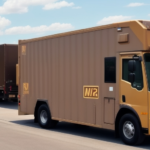Understanding International Shipping UPS Rates
When it comes to international shipping, selecting the right service provider is crucial for ensuring timely and cost-effective deliveries. UPS stands out as a leading choice, offering a diverse range of international shipping options tailored to various needs and budgets. But what makes UPS so popular, and how can you effectively understand and calculate their international shipping rates? This comprehensive guide delves into the intricacies of UPS international shipping rates, providing you with the essential information to make informed decisions.
Why UPS is a Popular International Shipping Service Provider
One of the primary reasons UPS dominates the international shipping landscape is its extensive global network. Covering over 220 countries and territories, UPS ensures that shipments reach almost any destination worldwide. This expansive network is supported by a robust infrastructure of distribution centers and strategic partnerships, enabling efficient and reliable deliveries.
Moreover, UPS offers a spectrum of international shipping options, ranging from economy services with longer transit times to express services with guaranteed delivery windows. This flexibility allows customers to choose the service that best aligns with their specific needs and budget constraints, providing both convenience and peace of mind.
Factors That Affect International Shipping Rates
Understanding the factors that influence UPS international shipping rates is essential for accurate cost estimation and budget planning. Key factors include:
- Package Weight and Dimensions: Heavier and larger packages incur higher shipping costs.
- Destination Country: The distance and specific regulations of the destination influence the rate.
- Service Type: Options like economy, standard, and express shipping have varying price points.
- Declared Value: Higher-value items may increase customs fees and insurance costs.
Additionally, the mode of transportation—air or sea—plays a significant role in determining shipping costs. Air freight is faster but typically more expensive, whereas sea freight is more economical for bulk shipments but takes longer.
In 2023, UPS reported a 10% increase in operational efficiency, which has positively impacted their international shipping rates by reducing overall costs.
How to Calculate UPS International Shipping Rates
Calculating UPS international shipping rates involves several key steps:
- Determine Shipment Details: Gather information about the origin and destination countries, package dimensions, weight, and the value of the items.
- Select Service Type: Choose between UPS services such as Worldwide Express, Worldwide Expedited, or Worldwide Saver based on your delivery timeline and budget.
- Use UPS Shipping Calculator: Input the collected information into the UPS online calculator to receive an estimated quote, which includes fees for duties, taxes, and customs clearance.
It's important to note that while the UPS online calculator provides a good estimate, the final shipping cost may vary based on specific shipment details and any additional services required.
For more detailed guidance, refer to our comprehensive UPS shipping rates chart.
How to Save Money on UPS International Shipping Rates
Reducing international shipping costs with UPS can be achieved through several strategies:
- Choose Economy Services: Opting for economy shipping can significantly lower costs, especially for non-urgent deliveries.
- Consolidate Shipments: Combining multiple shipments into one can reduce overall shipping fees and minimize customs charges.
- Optimize Packaging: Use appropriately sized packaging to avoid unnecessary dimensional weight charges and reduce the risk of damage.
- Leverage Contracts: Negotiating shipping contracts with UPS can lead to discounted rates for high-volume shippers.
- Book in Advance: Planning shipments ahead of time can help secure better rates and avoid last-minute price surges.
Additionally, utilizing a shipping calculator to compare rates across different carriers ensures you are getting the most competitive prices for your international shipments.
Understanding the Different UPS International Shipping Options Available
UPS offers a variety of international shipping options tailored to different needs:
- UPS Worldwide Express: Provides the fastest delivery with guaranteed delivery times and direct-to-door service.
- UPS Worldwide Expedited: Offers a balance between speed and cost, suitable for shipments that require faster delivery than economy services.
- UPS Worldwide Saver: A cost-effective option for shipments that are not time-sensitive, ensuring delivery within a few days.
- UPS Worldwide Express Freight: Designed for larger, heavier shipments requiring expedited delivery and specialized handling.
Each shipping option comes with specific restrictions and requirements, such as prohibited items and packaging standards. It's essential to review the UPS packaging guidelines to ensure compliance and avoid any shipping delays.
Tips for Packaging Your Items for International Shipping via UPS
Proper packaging is vital for safeguarding your items during international transit. Follow these best practices when packaging with UPS:
- Use Sturdy Boxes: Select high-quality, durable boxes designed to withstand international shipping conditions.
- Secure Fragile Items: Wrap delicate items in bubble wrap or other cushioning materials to prevent damage.
- Avoid Overpacking: Ensure boxes are not excessively packed, which can lead to difficulties during handling and increase the risk of damage.
- Label Clearly: Clearly and accurately label all packages to ensure they reach the correct destination without confusion.
Additionally, adhering to UPS’s packaging guidelines can help you avoid additional fees and ensure a smooth shipping process.
Common Mistakes to Avoid When Shipping Internationally with UPS
To ensure a seamless international shipping experience with UPS, avoid the following common mistakes:
- Incorrect Valuation: Failing to accurately declare the value of the items can result in insufficient insurance coverage or customs issues.
- Prohibited Items: Shipping restricted or prohibited items can lead to shipment confiscation or legal penalties.
- Poor Packaging: Inadequate packaging increases the risk of damage during transit and may incur additional costs.
- Incomplete Labels: Inaccurate or incomplete shipping information can cause delays and misrouting of your package.
Being mindful of these pitfalls can help ensure your shipments arrive safely and on time, avoiding unnecessary complications and expenses.
How to Track Your Shipment with UPS During International Shipping
UPS provides robust tracking capabilities to monitor your international shipments in real-time. To track your shipment:
- Visit the UPS Tracking Portal.
- Enter your tracking number in the designated field.
- Review the up-to-date status and location of your shipment.
For added convenience, you can opt to receive text or email notifications, keeping you informed about your shipment’s progress and delivery status.
The Pros and Cons of Using UPS for International Shipping
Choosing UPS for international shipping comes with its set of advantages and potential drawbacks:
Pros
- Global Reach: Extensive network covering over 220 countries and territories.
- Diverse Shipping Options: A range of services from economy to express to meet various needs.
- Reliable Tracking: Comprehensive tracking systems that provide real-time updates.
- Customer Support: Accessible customer service and support resources.
Cons
- Higher Costs: Express services can be significantly more expensive compared to other carriers.
- Customs Delays: Potential delays and fees related to customs clearance in certain regions.
- Complex Pricing: Shipping rates can be complex, with various factors influencing the final cost.
Overall, UPS remains a reliable and efficient choice for international shipping, particularly for businesses requiring dependable delivery services and comprehensive tracking capabilities.
Understanding Customs Regulations and Fees When Shipping Internationally with UPS
Navigating customs regulations and fees is a critical aspect of international shipping. When shipping with UPS, it's essential to understand the following:
- Destination Country Rules: Each country has specific import regulations, including restricted and prohibited items. Reviewing these regulations beforehand can prevent shipment delays or confiscation.
- Customs Clearance Process: UPS assists with the customs clearance process, but accurate documentation is crucial to avoid delays.
- Duties and Taxes: Import duties and taxes are determined by the destination country's regulations and are based on the declared value and type of items being shipped.
Staying informed about the customs requirements of your destination country and ensuring all paperwork is accurately completed can facilitate a smooth shipping experience. For detailed information, refer to the UPS Customs Guide.
Best Practices for Dealing with Customs When Using UPS for International Shipments
To minimize customs-related issues when shipping internationally with UPS, adhere to the following best practices:
- Complete Documentation: Ensure all required forms and paperwork are accurately filled out and submitted timely.
- Accurate Item Descriptions: Provide detailed and precise descriptions of the items to avoid confusion or suspicion.
- Compliance with Import Regulations: Familiarize yourself with and adhere to the import regulations of the destination country.
- Utilize a Customs Broker: For complex shipments, consider working with a customs broker to navigate the clearance process efficiently.
Implementing these practices can help ensure that your shipments clear customs without unnecessary delays or additional charges.
How to File a Claim with UPS for Lost or Damaged Items During International Shipping
If your shipment is lost or arrives damaged, it's crucial to file a claim promptly with UPS to seek compensation. Follow these steps to file a claim:
- Visit the UPS Claims Center.
- Select the appropriate claim type: lost or damaged items.
- Provide all necessary information and documentation, including:
- Tracking number
- Proof of value (e.g., invoice)
- Proof of loss or damage (e.g., photos of damaged items)
- Submit the claim through the UPS portal and await a response.
Ensure all information is accurate and submitted promptly to facilitate a swift resolution. UPS may request additional documentation, so maintain clear and thorough records of your shipment.
Expert Tips for Smooth and Successful International Shipping with UPS
Maximize your international shipping success with UPS by following these expert tips:
- Understand Destination Regulations: Research and comply with the import regulations of the destination country to avoid shipping delays.
- Select the Right Service: Choose a UPS service that aligns with your delivery timeline and budget.
- Proper Packaging: Invest in quality packaging materials to protect your items during transit.
- Track Your Shipment: Utilize UPS's tracking tools to monitor your shipment and address any issues promptly.
- Prepare for Customs: Ensure all customs paperwork is complete and accurate to facilitate smooth clearance.
- Plan for Contingencies: Be prepared for potential delays and have backup plans in place.
By implementing these strategies and leveraging UPS's reliable services, you can ensure a seamless and efficient international shipping experience.






















